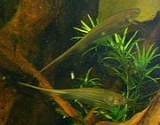
Glass knifefish
Encyclopedia
Glass knifefishes are fishes in the family Sternopygidae in the order Gymnotiformes
. Species are also known as rattail knifefishes.
These fishes inhabit freshwater
streams and rivers in Panama
and South America
. Many sternopygid species are specialized for life in the deep (>20 m) swiftly moving waters of large river channels, like that of the Amazon and its major tributares where they have been observed swimming vertically. Sternopygus species inhabit both streams and rivers.
Many species are highly compressed laterally and translucent in life. These fish have villiform (brush-like) teeth on the upper and lower jaws. The snout is relatively short. The eyes are relatively large, with a diameter equal to or greater than the distance between nares. The anal fin originates at the isthmus (the strip of flesh on the ventral surface between the gill covers). The maximum length is 140 cm in Sternopygus macrurus.
Eigenmannia vicentespelaea is the only cave-dwelling gymnotiform. Humboldtichthys kirschbaumi (formerly genus Ellisella) from Upper Miocene
of Bolivia is the only fossil gymnotiform.
These fish have a tone-like electric organ discharge (EOD) that occurs monophasically.
Some of these species are aquarium
fishes.
Family Sternopygidae
Gymnotiformes
The Gymnotiformes are a group of teleost bony fishes commonly known as the Neotropical or South American knifefishes. They have long bodies and swim using undulations of their elongated anal fin...
. Species are also known as rattail knifefishes.
These fishes inhabit freshwater
Freshwater
Fresh water is naturally occurring water on the Earth's surface in ice sheets, ice caps, glaciers, bogs, ponds, lakes, rivers and streams, and underground as groundwater in aquifers and underground streams. Fresh water is generally characterized by having low concentrations of dissolved salts and...
streams and rivers in Panama
Panama
Panama , officially the Republic of Panama , is the southernmost country of Central America. Situated on the isthmus connecting North and South America, it is bordered by Costa Rica to the northwest, Colombia to the southeast, the Caribbean Sea to the north and the Pacific Ocean to the south. The...
and South America
South America
South America is a continent situated in the Western Hemisphere, mostly in the Southern Hemisphere, with a relatively small portion in the Northern Hemisphere. The continent is also considered a subcontinent of the Americas. It is bordered on the west by the Pacific Ocean and on the north and east...
. Many sternopygid species are specialized for life in the deep (>20 m) swiftly moving waters of large river channels, like that of the Amazon and its major tributares where they have been observed swimming vertically. Sternopygus species inhabit both streams and rivers.
Many species are highly compressed laterally and translucent in life. These fish have villiform (brush-like) teeth on the upper and lower jaws. The snout is relatively short. The eyes are relatively large, with a diameter equal to or greater than the distance between nares. The anal fin originates at the isthmus (the strip of flesh on the ventral surface between the gill covers). The maximum length is 140 cm in Sternopygus macrurus.
Eigenmannia vicentespelaea is the only cave-dwelling gymnotiform. Humboldtichthys kirschbaumi (formerly genus Ellisella) from Upper Miocene
Miocene
The Miocene is a geological epoch of the Neogene Period and extends from about . The Miocene was named by Sir Charles Lyell. Its name comes from the Greek words and and means "less recent" because it has 18% fewer modern sea invertebrates than the Pliocene. The Miocene follows the Oligocene...
of Bolivia is the only fossil gymnotiform.
These fish have a tone-like electric organ discharge (EOD) that occurs monophasically.
Some of these species are aquarium
Aquarium
An aquarium is a vivarium consisting of at least one transparent side in which water-dwelling plants or animals are kept. Fishkeepers use aquaria to keep fish, invertebrates, amphibians, marine mammals, turtles, and aquatic plants...
fishes.
Species
There are thirty one living species of glass knifefish, grouped into six genera:Family Sternopygidae
- Genus Archolaemus
- Archolaemus blax
- Genus Distocyclus
- Distocyclus conirostris
- Distocyclus goajira
- Genus Eigenmannia
- Eigenmannia humboldtii
- Eigenmannia limbata
- Eigenmannia macrops
- Eigenmannia microstoma
- Eigenmannia nigra
- Eigenmannia trilineata
- Eigenmannia vicentespelaea
- Eigenmannia virescens
- Genus Rhabdolichops
- Rhabdolichops caviceps
- Rhabdolichops eastwardi
- Rhabdolichops electrogrammus
- Rhabdolichops jegui
- Rhabdolichops lundbergi
- Rhabdolichops navalha
- Rhabdolichops nigrimans
- Rhabdolichops stewarti
- Rhabdolichops troscheli
- Rhabdolichops zareti
- Genus Sternopygus
- Sternopygus aequilabiatus
- Sternopygus arenatus
- Sternopygus astrabes
- Sternopygus branco
- Sternopygus castroi
- Sternopygus macrurus - Longtail knifefish
- Sternopygus obtusirostris
- Sternopygus pejeraton
- Sternopygus xingu

